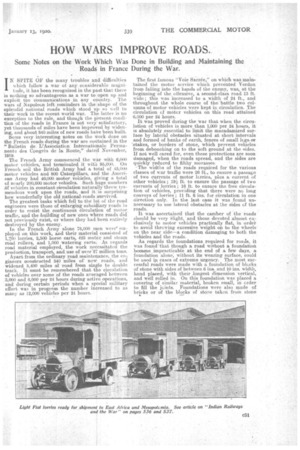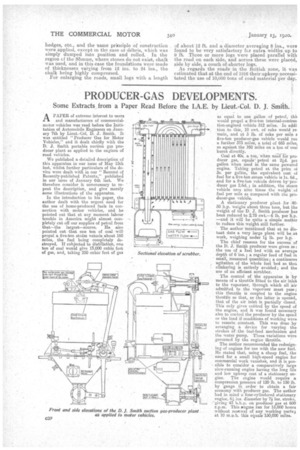HOW WARS IMPROVE ROADS.
Page 17

Page 18

If you've noticed an error in this article please click here to report it so we can fix it.
Some Notes on the Work Which Was Done in Building and Maintaining the Roads in France During the War.
IN SPITE OF the many troubles and difficulties which follow a war of any considerable magni7 tilde, it has been recognized in the past that there is nothing so advantageous as a war to open up and exploit the Communications in any country. The wars of Napoleon left reminders in the shape of the splendid national roads which stood up no well to their work in the-recent world war. The latter is no exception to the rulend though the present condition
n of the roads in trance is not very satisfactory, yet thousands of miles have been improved by widening, and about 540 miles of new roads have been built. Some very interesting notes on the work done on the French roads during the war are contained in the "Bulletin de L'Association Internationale Permanente des Congres de la Route," dated November, 1919.
The French Army commenced the war with 6,000 motor vehicles; and terminated it with 95,000., On French. soil the British Army had a total of 45,000 motor vehicles and BOO Caterpillars, and the American Army had 40,000 motor vehicles, giving a total of nearly 200,000 motor vehicles. Such huge numbers a vehicles in constant circulation naturally threw tremendous work upon the roads, and it is surprising how wonderfully the old national‘roads survived. The greatest tasks whieh fell to the lot of the road engineers were those of enlarging subsidiary roads in order to resist the continuous circulation of motor. traffic, and the building of new ones where roads did not previously exist, or where they had been entirely
destroyed by the enemy. .
In the French Army alone 78,000 men were' employed, on this work, and their material consisted of 1,:00 lorries, 2,500 horse carts,. 425 motcr and steam road rollers, and 1,000 watering carts.. As regards road material employed, the work necessitated the production, transport, and use of over 27million tons. Apart from the ordinary road maintenance, the era gineers eonst.ructed 540 miles of new roads, and widened 5,400 miles of road from -single to double track. It must be remembered that the circulation of vehicles over some of the roads averaged between 3,000 and 6,000 per 24 hours during active operations, and during. certain -periods when a. special military effort was in progress the number increased to as many as 12,000 vehicles per 24 hours. The first famous "Voie Sacree," on which was maintained the motor service which prevented Verdun from falling into the handa of the enemy, was, at the beginning of the offensive, a second-class road 13 ft. wide; this was increased to a width of 24 ft., and throughout the whole course of the battle two columns of motor vehicles were kept in circulation. The circulation of motcr vehicles on this road attained 6,000 per 24 hours. • It was proved during the war that when the circulation of vehicles is more than 1,000 per 24 hours, it is absolutely essential to limit the macadamized surface by later-al obstacles situated at short intervals and formed of banks of earth, fences of small logs or 'stakes, or borders of stone, which prevent vehicles from debouching on to the soft ground at the sides. If not well cared for, even these protections are soon damaged, when the roads spread., and the sides are quickly reduced to filthy morasses. The widths of the roads required for the various classes of war traffic were 26 ft., to ensure a. passage of two currents of motor lorries, obis a current of other vehicles ; ft. to ensure th.e passage of two currents of lorries ; 16 ft. to ensure the free circulation of vehicles, providing that there were no long convoys of lorries.; 11 ft. Q ins. for circulation in one direction only. In the last care it was found unnecessary to use lateral obstacles at the sides of the roads.
It was ascertained that the camber of the roads should be very Might, and those devoted almost exclusively to motor vehicles practically fiat, in order to avoid throwing excessive weight on to the wheels. on the near side—a condition damaging to both the vehicles and the roads.
As regards the foundations required for roails. it was found that though a, road without a, foundation became impracticable at the end of a few days, a foundation alone, without its wearing surface, could be used ip. cases of extreme urgency. The most successful roads were made with a foundation of blocks of stone with sides of between 6 ins. and 10 ins, width, hand placed, with their longest dimension vertical, and well rolled in. On this foundation was placed a covering of similar material, broken small, in order to fill the joints. Foundations were. also made of bricks or of the blocks of stone taken from stone
hedges, eta., and the .same principle of construction were applied, except in the case of debris, which was simply dumped into position and rolled. In the region cf the Stunme, where stones do not exist, chalk was used, and in this case the foundations were made of thicknesses varying from 12 ins. to 24 ins., the chalk being highly compressed. For enlarging the roads, small logs with a length
äf about 12 ft. and a diameter averaging 8 ins., were found to be very satisfactory kr extra widths up to 9 ft. Three or more logs were placed parallel with the road on each side, and across these were placcd, side by side, a couch of shorter logs.
As rega.rds the roads in the British zone, it Was estimated that at the end of 1016 their upkeep necessitated the use of 10,000 tons of road material Per day.


























